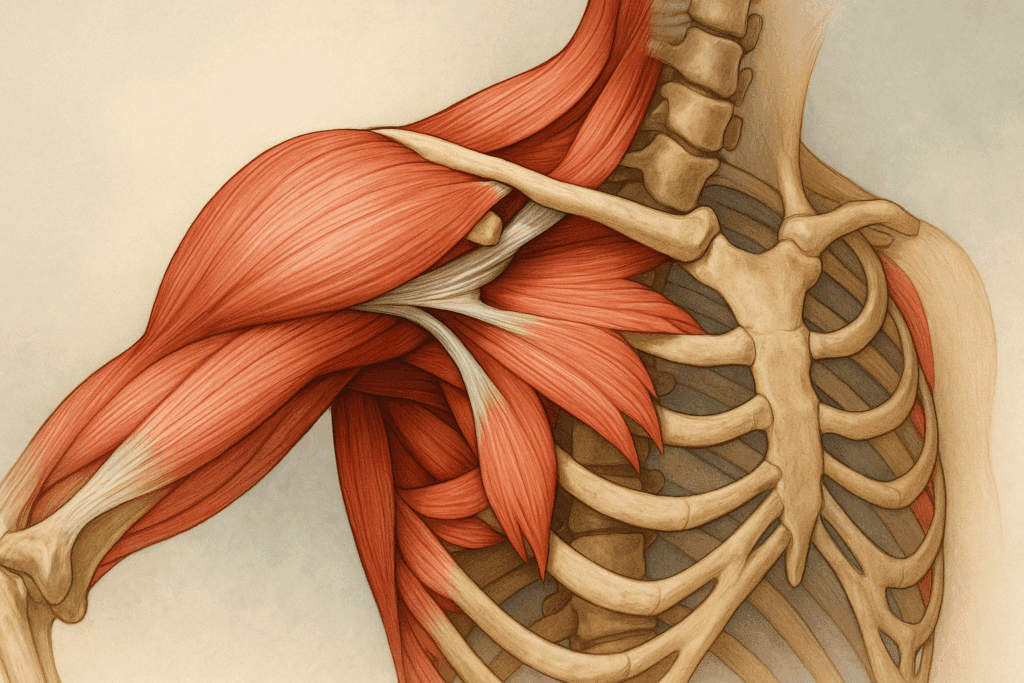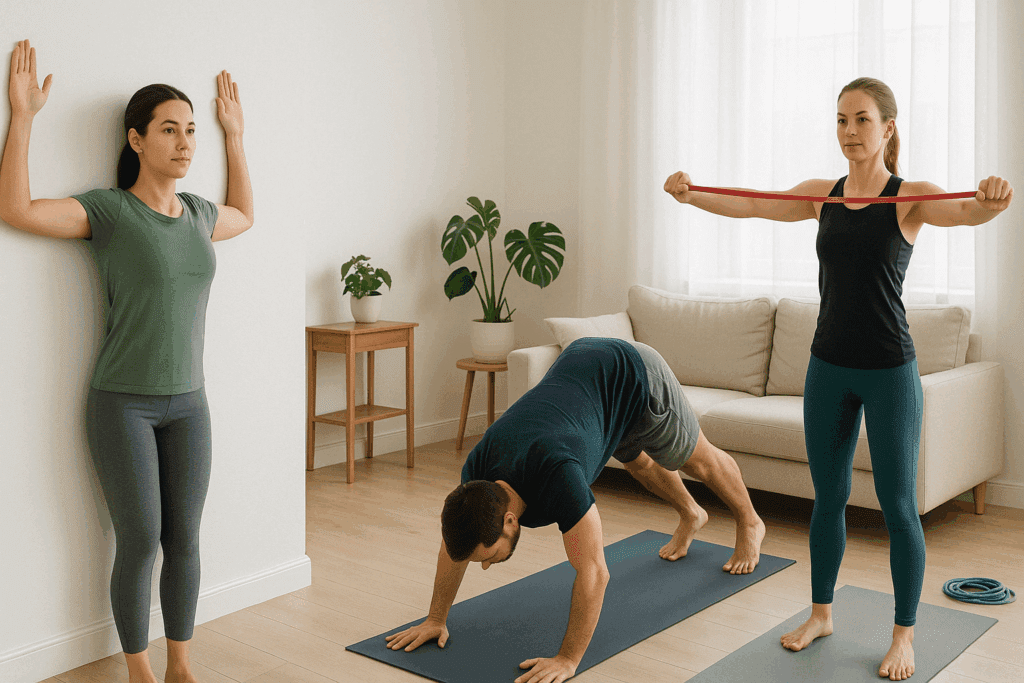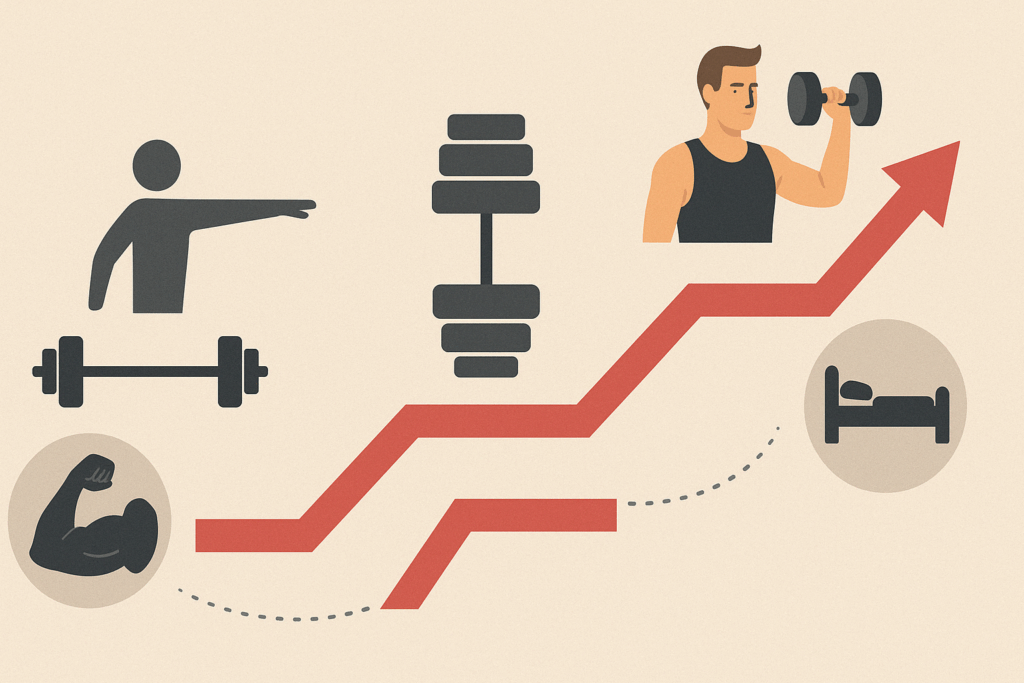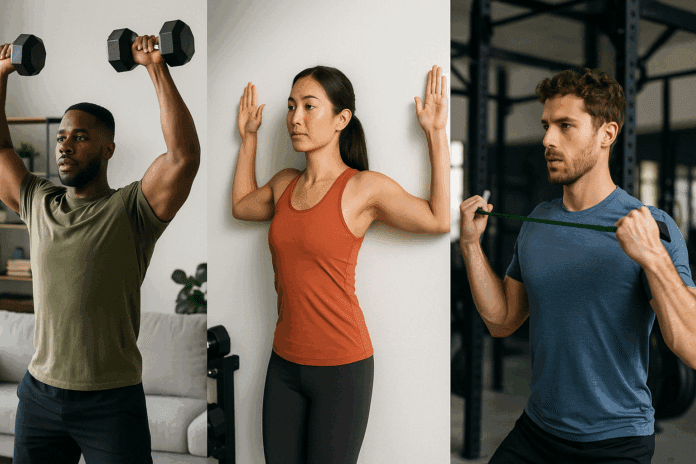The shoulder is a remarkably mobile and complex joint, responsible for an extraordinary range of motion that few other joints in the human body can match. From reaching overhead to rotating in multiple directions, this anatomical marvel allows us to perform essential daily activities and advanced athletic maneuvers alike. However, because of its incredible flexibility, the shoulder is also uniquely vulnerable to injury, instability, and long-term dysfunction. As such, incorporating the best shoulder strengthening exercises into your fitness routine is not just about improving performance—it’s a crucial component of preserving joint integrity and ensuring long-term shoulder fitness. Whether you’re training at home or in the gym, the right movements can significantly enhance shoulder stability, mobility, and resilience.
You may also like : Best Stretches for Sore Legs and Tight Thigh Muscles: How to Relieve Upper Leg Pain Safely and Naturally
Developing shoulder strength involves more than simply lifting heavy weights. True shoulder fitness requires a deliberate focus on balance: strengthening the deltoid, rotator cuff, scapular stabilizers, and even the thoracic spine muscles that support proper posture. In this article, we’ll explore evidence-based, expert-recommended shoulder exercises suitable for various fitness levels. Each movement is designed to improve functional mobility, prevent common injuries, and promote the kind of structural alignment that supports lifelong shoulder health.

Why Shoulder Strength Matters for Lifelong Joint Health
Understanding why shoulder strength is essential begins with recognizing the joint’s structural characteristics. The shoulder is a ball-and-socket joint, but unlike the hip—which is deeply embedded and highly stable—the shoulder socket is shallow. This allows for unparalleled movement, but it also relies heavily on surrounding muscles, tendons, and ligaments for support. Weakness in any of these structures can lead to common issues such as impingement syndrome, rotator cuff tears, or chronic inflammation.
Shoulder fitness becomes increasingly vital with age. Muscle atrophy, degenerative changes, and reduced mobility can significantly impair function in older adults. But even among younger populations, poor posture—especially from prolonged desk work or screen time—contributes to rounded shoulders and forward head posture, which can destabilize the shoulder girdle and lead to pain. By integrating the best shoulder strengthening exercises into regular workouts, individuals can mitigate these risks and create a foundation for joint longevity.
Beyond injury prevention, a strong shoulder complex enhances performance in virtually every upper body activity. From lifting and throwing to swimming and climbing, shoulder strength is indispensable. The best strength exercises for shoulders also contribute to core stability and upper body symmetry, key elements of balanced and injury-resistant fitness. Whether you’re an athlete, a weekend warrior, or simply someone aiming for healthier movement patterns, shoulder strengthening workouts are fundamental to reaching your goals.
Anatomy-Informed Approach to the Best Shoulder Workouts
To effectively design a workout for shoulder strength, it’s essential to understand the key muscles involved. The deltoid muscle, which caps the shoulder, is responsible for arm abduction, flexion, and extension. It’s composed of three distinct heads: anterior, lateral, and posterior. Comprehensive shoulder exercises should target all three to promote balanced development and functional strength.
The rotator cuff, made up of the supraspinatus, infraspinatus, teres minor, and subscapularis, plays a crucial role in stabilizing the shoulder joint. These small but powerful muscles are often neglected in traditional gym workouts, leading to imbalances and injury. Incorporating targeted movements to activate these stabilizers is a hallmark of the best shoulder strengthening exercises.
Another critical area is the scapular stabilizers, including the trapezius, rhomboids, and serratus anterior. These muscles control the movement and positioning of the shoulder blade, which acts as the foundation for all arm movements. Without proper scapular control, even the most well-intentioned shoulder workouts can fall short—or worse, contribute to dysfunction. Effective shoulder exercises train the entire kinetic chain, improving coordination between muscles and enhancing total joint performance.

The Role of Functional Movement Patterns in Shoulder Strengthening
Functional movement is a term often used in rehabilitation and strength training circles, but its specific application to shoulder fitness is profound. Functional shoulder exercises mimic the dynamic, multi-planar movements we perform in daily life and athletic activities. Unlike isolated gym-based exercises, these movements challenge the shoulder in positions of rotation, flexion, and stabilization simultaneously—training it to operate effectively in real-world contexts.
For example, movements like the Turkish get-up, kettlebell windmill, or overhead carry challenge not just the deltoids and rotator cuff, but the entire kinetic chain. These exercises require core engagement, spinal alignment, and scapular control, offering a more integrative and neurologically demanding stimulus than traditional shoulder presses. The shoulder does not operate in isolation, and strengthening it through compound, functional movement ensures better carryover to tasks like lifting groceries, playing sports, or simply maintaining healthy posture at a desk.
Athletes and fitness professionals increasingly prioritize these kinds of movements in shoulder strengthening workouts because they condition the shoulder to react, stabilize, and support weight in unstable, asymmetrical positions. For individuals seeking not just muscle mass but resilient, real-world shoulder function, functional movement training is indispensable.

Rehabilitating the Shoulder After Injury: A Phased Approach
Shoulder injuries—ranging from rotator cuff tears and labral issues to impingement syndromes—are among the most common orthopedic problems, especially for overhead athletes and aging populations. A safe and effective return to activity requires a deliberate, phased rehabilitation strategy that restores range of motion, strength, neuromuscular control, and confidence in movement.
In the acute phase of shoulder rehab, the priority is reducing pain and inflammation while maintaining as much gentle mobility as possible. Pendulum swings, isometric holds, and pain-free passive range-of-motion work are common. As healing progresses, early strengthening exercises for the rotator cuff and scapular stabilizers are introduced. These include internal and external rotations with light bands, scapular retractions, and prone T and Y raises.
As the individual regains strength and control, the integration phase begins. This is where more dynamic shoulder exercises are reintroduced, with an emphasis on eccentric loading and closed kinetic chain movements—such as wall slides, quadruped reaches, and bear crawls. These movements challenge the shoulder in multiple planes and help rebuild the brain’s confidence in the joint’s ability to stabilize dynamically.
The final stage, return to performance, involves sport- or activity-specific strengthening. Athletes may resume pressing, pulling, and throwing movements with a focus on form, load tolerance, and speed. Understanding the timeline and structure of this rehabilitation progression is crucial for anyone dealing with or recovering from shoulder injury. It also helps prevent the all-too-common pattern of re-injury due to premature progression or neglect of the stabilizing muscles.
The Science of Scapular Mechanics: Why Shoulder Blade Control Matters
The scapula, or shoulder blade, serves as the foundation for all upper arm movements. It must glide, rotate, and tilt in coordination with the humerus (upper arm bone) for the shoulder joint to function properly. When scapular mechanics are impaired—due to weakness, stiffness, or poor neuromuscular control—the result is often faulty movement patterns and excessive stress on the rotator cuff.
One of the most underappreciated aspects of shoulder training is scapular upward rotation, which is necessary during any overhead movement. The serratus anterior, lower trapezius, and upper trapezius all contribute to this action. Deficits in these muscles often lead to “winging” scapula or poor shoulder blade positioning, which compromises stability and power.
To train scapular mechanics, exercises like serratus wall slides, forearm wall lifts, and scaption with thumbs up can be highly effective. These movements emphasize not just strength, but also precision and control. Athletes, in particular, should prioritize scapular training as part of their regular shoulder strengthening workouts, especially if they participate in throwing, swimming, or racquet sports.

Best Shoulder Exercises at Home: Building Strength Without Equipment
One of the biggest misconceptions in fitness is that you need heavy weights or complicated machines to build strong shoulders. In reality, some of the best shoulder exercises at home require nothing more than your body weight and a bit of floor space. For individuals recovering from injury or just beginning their strength journey, these exercises provide a safe, accessible, and highly effective option.
Wall angels are a perfect example. This deceptively simple movement involves standing with your back against a wall, raising and lowering your arms in a controlled arc, and focusing on maintaining contact between the wall and your elbows. Wall angels activate the posterior deltoids and scapular stabilizers while encouraging thoracic spine extension—making them ideal for correcting postural imbalances.
Pike push-ups are another standout. These resemble traditional push-ups but are performed with the hips elevated, mimicking an overhead press movement. Pike push-ups develop the anterior deltoid and triceps while engaging the core for additional stability. They are one of the most effective bodyweight options for targeting shoulder strength.
Even resistance bands can be used for shoulder strengthening workouts when weights aren’t available. Exercises like band pull-aparts and face pulls target the rear delts and rotator cuff muscles, fostering the muscular balance necessary for healthy joint mechanics. These easy shoulder exercises are particularly valuable for individuals who need low-impact yet highly effective options that can be performed consistently at home.
Best Shoulder Strengthening Exercises with Weights and Equipment
For those with access to a gym or a well-stocked home workout space, the range of options for shoulder strengthening expands dramatically. Traditional compound lifts, such as the overhead press, dumbbell shoulder press, and Arnold press, are among the best strength exercises for shoulders due to their ability to target multiple muscle groups simultaneously. These movements not only develop hypertrophy in the deltoids but also challenge the core and upper back to maintain stability under load.
Lateral raises and front raises, often performed with dumbbells or cables, isolate specific parts of the deltoid muscle. These movements are useful for developing definition and correcting imbalances between the front, side, and rear portions of the shoulder. Care should be taken to execute these exercises with proper form, as swinging or using momentum can shift the load away from the target muscles and increase injury risk.
Face pulls using a rope attachment on a cable machine are widely regarded as one of the best shoulder exercises for correcting posture and strengthening the rotator cuff. This exercise not only targets the rear delts but also reinforces external rotation, which counters the common tendency toward internal rotation caused by excessive chest training or poor ergonomics. Integrating these movements into shoulder workouts helps to ensure structural integrity while building functional strength.

Dynamic Shoulder Mobility Workouts for Long-Term Flexibility
While strength is essential, mobility is equally critical for maintaining healthy shoulders. Mobility refers to the ability of a joint to move freely through its full range of motion. Without adequate mobility, even the strongest shoulders can become prone to overuse injuries and movement compensations. The best shoulder workouts integrate dynamic mobility exercises alongside strength training to create a holistic approach to joint care.
Controlled articular rotations (CARs) are one of the most effective ways to maintain and improve shoulder mobility. This technique involves moving the shoulder joint through its entire range of motion in a slow, deliberate manner. CARs enhance joint capsule health, improve neuromuscular control, and help detect and correct movement deficits before they lead to injury.
Incorporating thoracic spine mobility drills, such as open books and foam roller extensions, can also enhance shoulder movement. The thoracic spine plays a crucial role in overhead mobility; stiffness in this region can compromise shoulder mechanics and place undue stress on the joint. When performed regularly, these exercises improve posture, facilitate overhead movements, and support long-term shoulder fitness.
Shoulder dislocates using a dowel rod or resistance band are another classic mobility drill. Contrary to what the name suggests, this exercise does not involve actual dislocation. Instead, it involves slowly moving the arms over and behind the body while keeping the elbows extended, stretching the anterior shoulder and chest muscles. Done with control and intention, shoulder dislocates improve range of motion and help prevent impingement.

Progressive Overload and Periodization for Shoulder Workouts
One of the most important principles in shoulder strengthening workouts is progressive overload—the gradual increase of stress placed on the shoulder muscles to stimulate growth and adaptation. Without progressive overload, even the best shoulder workouts will eventually lead to plateaus. This principle can be applied in several ways, including increasing resistance, adjusting tempo, modifying rest intervals, or adding complexity to movements.
Periodization refers to the systematic planning of training phases to optimize performance and recovery. In the context of shoulder fitness, periodization allows for cycles of strength building, hypertrophy, mobility, and deloading. For example, a four-week block might focus on building overhead pressing strength, followed by a phase emphasizing scapular stability and mobility work. This cyclical approach reduces the risk of overtraining and ensures well-rounded development.
Tracking progress is critical. Keeping a training journal or using fitness tracking apps can help monitor increases in load, volume, and technique. This data-driven approach not only ensures accountability but also helps tailor shoulder exercises to individual needs and limitations. Consistency, coupled with intelligent programming, is the foundation of effective long-term shoulder health.
Avoiding Common Mistakes in Shoulder Training
Even well-meaning individuals can undermine their shoulder health by making common training mistakes. One of the most frequent errors is overemphasizing anterior deltoid development through excessive pressing exercises while neglecting the rear deltoids and rotator cuff. This imbalance creates a forward shoulder posture and increases the likelihood of shoulder impingement.
Another issue is poor exercise form, often caused by lifting weights that are too heavy. Using improper technique not only reduces the effectiveness of shoulder exercises but can also place dangerous stress on the joint and surrounding structures. Prioritizing quality over quantity, especially during complex movements like the overhead press, is crucial for safety and results.
Neglecting warm-up and mobility work is a third common misstep. Jumping straight into heavy shoulder exercises without preparing the joint with mobility drills and activation sets can lead to strain and reduced performance. A well-structured warm-up enhances neuromuscular coordination, improves range of motion, and primes the body for more demanding work.
The Role of Shoulder Workouts in Posture, Performance, and Pain Prevention
Strong, mobile shoulders are integral to good posture. The shoulder girdle interacts closely with the spine, neck, and rib cage. When the muscles of the upper back and shoulders are weak or tight, it often leads to a hunched posture, which can cascade into neck pain, back discomfort, and even reduced lung capacity. Integrating shoulder strengthening workouts into a broader postural strategy can dramatically improve both appearance and functional well-being.
In terms of athletic performance, nearly every sport benefits from better shoulder mechanics. Whether it’s a tennis serve, baseball pitch, swimming stroke, or gymnastic maneuver, shoulder stability and strength enhance power transfer, reduce injury risk, and enable smoother, more efficient movement. The best shoulder strengthening exercises contribute not just to local muscle development, but also to global performance improvement.
Finally, shoulder workouts play a key role in managing and preventing chronic pain. Conditions like frozen shoulder, tendinitis, and bursitis are often exacerbated by disuse and weakness. Targeted shoulder exercises, particularly those that include isometric holds and eccentric contractions, have been shown in clinical settings to alleviate symptoms and restore function. A proactive approach to shoulder fitness can be transformative for individuals dealing with persistent discomfort.
Frequently Asked Questions: Advanced Insights into Shoulder Strengthening and Fitness
1. How can I ensure long-term shoulder stability beyond basic strengthening?
While basic shoulder exercises like presses and rows build strength, long-term stability demands a more integrative approach. One advanced strategy is incorporating reactive and anti-rotational drills such as landmine presses and single-arm farmer’s carries, which force the shoulder to resist movement in multiple planes. These enhance not only strength but also neurological control—key for maintaining alignment under unpredictable real-world conditions. To future-proof your shoulder fitness, consider adding balance-based drills and closed-chain exercises into your shoulder strengthening workouts. These approaches move beyond the best strength exercises for shoulders by addressing motor control and proprioception, critical for joint longevity.
2. What’s the connection between shoulder fitness and breathing mechanics?
Surprisingly, poor breathing habits can impact shoulder function, especially in those with shallow chest-dominant breathing patterns. When the diaphragm isn’t fully engaged, accessory breathing muscles like the scalenes and upper traps can become overactive, creating tension in the shoulder girdle. Practicing diaphragmatic breathing while performing shoulder exercises can help relax these compensatory muscles, improving range of motion and reducing strain. Breath-centered movement also enhances core stability, which indirectly supports scapular control during shoulder strengthening workouts. This connection offers a lesser-known but powerful method for refining even the best shoulder workouts.
3. Are there psychological factors that influence shoulder pain or strength outcomes?
Yes, mental states like anxiety, fear of movement, and stress have been shown to influence both perceived pain and actual motor control in the shoulder complex. When individuals catastrophize or brace against discomfort, they may unconsciously inhibit shoulder stabilizers or rely on maladaptive movement patterns. Cognitive strategies—such as graded exposure, mindfulness training, or mental rehearsal—can complement physical therapy and even the best shoulder strengthening exercises. Integrating these practices into your workout for shoulder stability may improve outcomes by reducing fear-avoidance behaviors and promoting efficient, confident movement. Mental resilience can enhance physical performance just as much as muscular strength.
4. What are some of the best shoulder exercises at home that go beyond basic bodyweight training?
Once you’ve mastered easy shoulder exercises like wall slides and pike push-ups, it’s time to progress to more challenging at-home movements that still require minimal equipment. Resistance band shoulder dislocates, single-arm plank taps, and isometric overhead holds using a backpack or water jug add resistance without compromising form. These are among the best shoulder exercises at home because they train both strength and endurance under variable tension. By mixing dynamic and isometric actions, these exercises provide a well-rounded stimulus similar to advanced gym-based routines. They also promote the kind of deep stabilizer engagement essential to advanced shoulder fitness.
5. How can athletes tailor their shoulder strengthening workouts for sport-specific performance?
Athletes benefit most when their shoulder workouts mimic the demands of their sport. For example, swimmers might prioritize internal and external rotation under load, while tennis players may focus on explosive overhead motions. Sport-specific shoulder exercises such as medicine ball throws, resistance band chops, or deceleration drills help condition the shoulder to handle sudden load changes. These are not just variations of the best exercises for shoulders—they are targeted applications that improve reaction speed, resilience, and directional control. Tailored shoulder strengthening workouts should always consider the unique angles, intensities, and frequencies of movement required by the athlete’s discipline.
6. What role does the thoracic spine play in shoulder performance?
Thoracic spine mobility is a foundational but often overlooked element in any workout for shoulder health. A stiff thoracic spine can compromise scapular movement and force the shoulder joint to overcompensate during overhead activities. Mobilizing this area with foam rollers, cat-cow variations, or open-book drills can significantly enhance the effectiveness of shoulder exercises. When your thoracic spine is moving freely, even the best shoulder strengthening exercises become more powerful and safer. This relationship underscores the importance of addressing full-body mobility as part of your shoulder fitness plan.
7. Can shoulder imbalances be corrected through unilateral training?
Unilateral shoulder exercises—where each arm works independently—are among the most effective ways to detect and correct strength or stability discrepancies between sides. Movements like single-arm overhead presses, suitcase carries, and one-arm face pulls not only expose imbalances but also force underactive stabilizers to engage. This makes them some of the best strength exercises for shoulders that struggle with asymmetry. Over time, these movements improve neuromuscular coordination, correct posture, and promote even muscular development. They’re particularly useful in shoulder strengthening workouts for those recovering from injury or transitioning out of a sedentary lifestyle.
8. How often should shoulder workouts be incorporated into a fitness routine?
The ideal frequency depends on your training volume and goals, but most people benefit from including focused shoulder work two to three times per week. For general fitness, this might mean alternating between pressing days and pull-apart or rear-delt-focused days to maintain muscular balance. Advanced trainees may incorporate mini shoulder workouts shoulders into their warm-ups or cooldowns to reinforce activation without adding excessive fatigue. Integrating both compound and isolation work within this frequency ensures that the best shoulder workouts support functional strength and endurance. Consistency and recovery are just as important as exercise selection.
9. What are common mistakes to avoid in shoulder workouts, especially for beginners?
A frequent mistake is overemphasizing the front deltoid with pressing variations while neglecting the posterior chain and rotator cuff. This imbalance can lead to poor posture, joint instability, and even chronic pain. Beginners may also rush into heavy lifting before mastering foundational shoulder exercises, increasing the risk of strain. Skipping warm-ups or mobility work is another misstep that reduces the effectiveness of even the best exercises for shoulders. To avoid these pitfalls, structure your shoulder workouts with a balance of pushing, pulling, and rotational movements, and emphasize control over load.
10. How are technology and innovation shaping the future of shoulder fitness?
The rise of wearable tech, motion capture systems, and app-based coaching platforms is transforming how shoulder fitness is measured and programmed. Smart sensors can now track scapular movement and muscle engagement during shoulder strengthening workouts, providing real-time feedback on form. Virtual coaching tools offer customized workout for shoulder routines, often adapting based on performance trends and injury history. These innovations enable highly individualized training and ensure even the best shoulder strengthening exercises are performed with precision. As tech continues to evolve, expect greater integration of biomechanics, data analytics, and AI-driven personalization in shoulder care strategies.
Conclusion: Prioritizing the Best Shoulder Strengthening Exercises for Lifelong Joint Health and Performance
In the pursuit of total-body fitness, the shoulders deserve special attention. These dynamic, highly mobile joints are essential for both everyday function and athletic excellence, yet they are uniquely prone to injury when neglected or improperly trained. The best shoulder strengthening exercises, whether performed at home or in the gym, address not only muscular strength but also mobility, stability, and coordination. By targeting all aspects of the shoulder complex—including the deltoids, rotator cuff, and scapular stabilizers—individuals can build resilience, improve posture, and prevent chronic pain.
Whether you’re a beginner looking for easy shoulder exercises or an advanced trainee aiming to refine your workout for shoulder stability and power, the principles remain the same: consistency, proper form, and a holistic approach. From bodyweight drills and resistance bands to free weights and mobility tools, a wide range of accessible options exists to promote long-term shoulder fitness.
Ultimately, incorporating shoulder strengthening workouts into your regular routine is not just a recommendation—it’s a necessity. A strong, mobile, and pain-free shoulder complex enables better movement, greater strength, and a higher quality of life. By prioritizing the best shoulder exercises today, you’re investing in your health, functionality, and physical independence for years to come.
Was this article helpful? Don’t let it stop with you. Share it right now with someone who needs to see it—whether it’s a friend, a colleague, or your whole network. And if staying ahead on this topic matters to you, subscribe to this publication for the most up-to-date information. You’ll get the latest insights delivered straight to you—no searching, no missing out.
Further Reading:
8 Best Shoulder Exercises: A Beginner’s Guide


